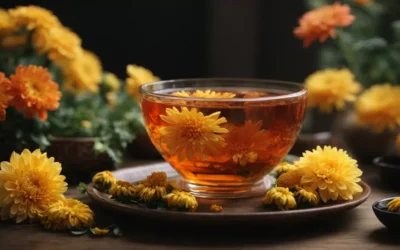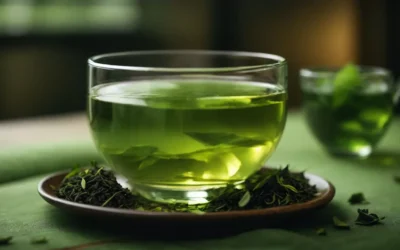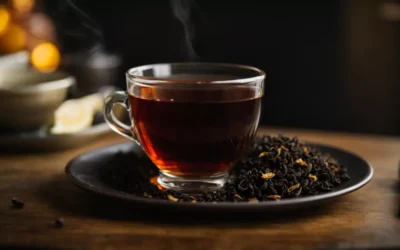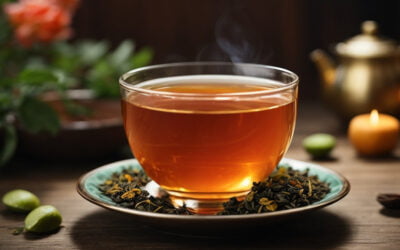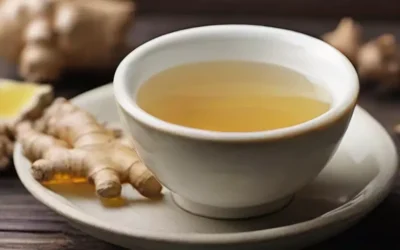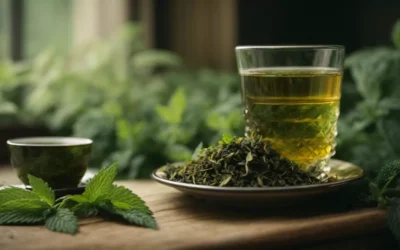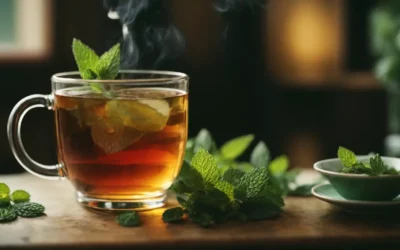Oolong tea, a traditional Chinese tea with a rich history and unique flavor, occupies a special place in the world of tea enthusiasts. Falling between green and black tea in terms of oxidation, oolong offers a distinct taste profile that sets it apart. With its partially oxidized leaves, oolong strikes the perfect balance between the fresh grassy notes of green tea and the robustness of black tea. This results in a complex flavor profile that can range from floral and fruity to toasty and nutty. But oolong is not just about its delightful taste. It also boasts numerous health benefits, such as aiding digestion, promoting weight loss, and providing antioxidants that support overall well-being. No wonder it has gained popularity worldwide among those seeking both pleasure and wellness from their cup of tea. Let’s explore the fascinating world of oolong tea – its origins, flavors, brewing techniques, and health benefits.
- What is Oolong Tea?
- Oolong Tea Origins
- Varieties of Oolong Tea
- How Oolong Tea is Made
- Tasting Oolong Tea
- Caffeine Content in Oolong Tea
- Buying and Storing Oolong Tea
- Preparing Oolong Tea
- FAQs
What is Oolong Tea?
Oolong tea, derived from the leaves of the Camellia sinensis plant, is a unique and flavorful beverage that sits between green and black tea in terms of oxidation. This partially oxidized tea offers a wide range of flavors, from floral and fruity to woody and roasted. The level of oxidation determines the color, aroma, and taste of oolong teas.
Partial Oxidation: The Magic Behind Oolong Tea
Oolong tea undergoes a special process known as partial oxidation. Unlike green tea which is unoxidized or black tea which is fully oxidized, oolong falls somewhere in between. During oxidation, the enzymes present in the leaves interact with oxygen in the air, resulting in chemical changes that give oolong its distinct characteristics.
A Spectrum of Flavors
One of the most fascinating aspects of oolong tea is its diverse range of flavors. Depending on the level of oxidation, different varieties can offer an array of taste profiles. Some oolongs have a delicate floral note reminiscent of orchids or honeysuckle, while others exhibit fruity undertones like peaches or apples. On the other end of the spectrum, you’ll find robust oolongs with earthy and roasted flavors akin to nuts or caramel.
Beautifully Balanced Brews
What sets Oolong apart from other teas is its ability to strike a harmonious balance between sweetness and bitterness. While some teas lean heavily towards one end of this spectrum, oolongs manage to find equilibrium in their flavor profiles. This delicate balance makes them incredibly enjoyable to drink without being too overpowering.
An Invigorating Aroma
In addition to its delightful taste, oolong tea also boasts an invigorating aroma that can transport you to serene landscapes filled with blooming flowers or lush forests. Each sip brings forth fragrant notes that awaken the senses and add to the overall experience of savoring this unique beverage.
The Art of Oolong Tea Production
Crafting oolong tea is truly an art form. Skilled tea artisans carefully monitor the oxidation process, allowing the leaves to wither and oxidize for a specific duration before halting the process at just the right moment. This meticulous attention to detail ensures that each batch of oolong tea achieves its desired flavor profile.
Health Benefits of Oolong Tea
Oolong tea not only delights the taste buds but also offers potential health benefits. While more research is needed, some studies suggest that oolong tea may contribute to weight management by boosting metabolism and reducing fat absorption. It may also support heart health by helping to lower cholesterol levels and promote healthy blood pressure.
Exploring Oolong Tea Varieties
With such a diverse range of flavors, exploring different oolong varieties can be an exciting journey for tea enthusiasts.
Oolong Tea Origins
Oolong tea, a beloved beverage enjoyed by many, has a fascinating history that dates back to ancient China. Let’s dive into the origins of this delightful tea and explore the regions where it is produced.
Ming Dynasty Birthplace
During the Ming Dynasty, which spanned from 1368 to 1644, oolong tea made its debut in China. This period marked a significant turning point for tea production and consumption in the country. The cultivation and processing techniques used during this time laid the foundation for the creation of oolong tea as we know it today.
Fujian Province: Home of Fine Oolongs
One cannot overlook the Fujian province in southeastern China. Renowned for its picturesque landscapes and rich tea culture, Fujian boasts an ideal environment for growing tea plants. The unique combination of mountainous terrain, fertile soil, and favorable climate contributes to the exceptional quality of oolongs produced in this region.
Taiwan’s Oolong Delights
While Fujian may be synonymous with oolong production, Taiwan also holds its own. Taiwanese oolongs are highly regarded for their distinct flavors and aromas. The island’s high mountains provide optimal conditions for growing tea plants at higher elevations, resulting in teas with unique characteristics that captivate connoisseurs worldwide.
Wuyi Mountains: A Treasure Trove
Nestled within the Fujian province lies the majestic Wuyi Mountains, a UNESCO World Heritage site known for its breathtaking beauty and remarkable biodiversity. This region is not only home to stunning landscapes but also serves as a treasure trove for oolong enthusiasts. The rocky terrain combined with misty weather creates an ideal microclimate that imparts extraordinary flavors and complexities into Wuyi oolongs.
Anxi: Birthplace of Tie Guan Yin
Anxi, a county located in the Fujian province, holds a special place in the hearts of tea aficionados as it is the birthplace of Tie Guan Yin, one of China’s most famous oolong teas. The unique processing method used for Tie Guan Yin involves rolling and shaping the leaves into tight balls, resulting in a distinctive appearance and flavor profile. Tea lovers around the world appreciate this tea for its floral fragrance and smooth taste.
Guangdong’s Lingering Charm
Moving southward to Guangdong province, we find another region that contributes to the diverse world of oolong teas. While not as well-known as Fujian or Taiwan, Guangdong has its own charm. This coastal province benefits from a subtropical climate and fertile soil, creating favorable conditions for growing tea plants. Oolongs from Guangdong often exhibit a milder flavor profile with hints of sweetness.
Varieties of Oolong Tea
Tie Guan Yin
Tie Guan Yin is a popular variety of oolong tea that originates from China. It is known for its unique combination of floral notes and a smooth finish. When brewed, this tea releases a delicate aroma that fills the air with hints of orchids and lilacs. The taste is equally delightful, offering a balance between sweetness and earthiness. Sipping on Tie Guan Yin feels like taking a stroll through a blooming garden on a sunny spring day.
Da Hong Pao
If you’re looking for a bold and robust flavor, look no further than Da Hong Pao, also known as “Big Red Robe.” This oolong tea hails from the Wuyi Mountains in China and has gained worldwide recognition for its exceptional taste. When steeped, it imparts rich flavors reminiscent of dark chocolate and honey. The deep amber color of the brew adds to the allure, inviting you to indulge in its full-bodied goodness. Da Hong Pao truly lives up to its reputation as one of the finest teas in the world.
Oriental Beauty
Oriental Beauty is an extraordinary Taiwanese oolong tea that stands out due to its unique production process. Unlike other varieties, this tea undergoes partial oxidation during growth because it’s intentionally exposed to small insects called leafhoppers. These insects bite the leaves, triggering chemical reactions that result in distinct flavors and aromas. As strange as it may sound, these insect bites contribute to Oriental Beauty’s sweet notes and complex character. With each sip, you’ll discover layers of fruity sweetness with hints of peach or honeydew melon. Exploring different varieties can be an exciting journey filled with pleasant surprises for your taste buds. Each type offers its own distinct characteristics that make it stand out from the rest. Let’s take a closer look at these oolong tea varieties: Pros of Tie Guan Yin:
- Delicate floral notes and a smooth finish.
- Offers a balanced taste between sweetness and earthiness.
Cons of Tie Guan Yin:
- May not appeal to those who prefer stronger flavors.
- The delicate nature of the tea requires careful brewing to avoid overpowering the flavors.
Pros of Da Hong Pao:
- Bold and robust flavor with hints of chocolate and honey.
- Full-bodied brew that leaves a lasting impression.
Cons of Da Hong Pao:
- Can be quite expensive due to its rarity and high demand.
- Requires precise brewing techniques to bring out the best flavors.
Pros of Oriental Beauty:
- Unique sweet notes resulting from insect bites on the leaves.
- Complex character with fruity undertones.
Cons of Oriental Beauty:
- Limited availability compared to other oolong teas.
- The production process involving insects may deter some individuals.
How Oolong Tea is Made
Plucking
To make oolong tea, only mature leaves are carefully picked by hand or machine. This ensures that the leaves used in the tea-making process are of the highest quality. The plucking stage is crucial as it determines the flavor and aroma of the final product. By selecting only mature leaves, tea producers can ensure a rich and robust taste.
Withering
After the plucking stage, the leaves are spread out to undergo withering. During this process, moisture is naturally removed from the leaves under controlled conditions. This step helps to reduce the water content in the leaves and prepares them for further processing. By removing excess moisture, the flavors and aromas within the leaves become more concentrated.
Oxidation
Once withering is complete, the next step in making oolong tea involves oxidation. During this stage, the leaves are bruised or rolled to initiate oxidation. Oxidation refers to a chemical reaction that occurs when enzymes within the leaves come into contact with oxygen in the air. This reaction leads to changes in flavor and color. Oxidation plays a significant role in determining whether a tea will be classified as green tea (unoxidized), black tea (fully oxidized), or oolong tea (partially oxidized). For oolong tea production, oxidation is allowed to occur partially before being halted through firing or heating.
Firing
Firing is a critical step in making oolong tea as it stops oxidation and preserves its unique characteristics. After partial oxidation has taken place, heat is applied to halt this process. The firing technique can vary depending on regional traditions and preferences. Traditional methods involve using hot pans or baskets over charcoal fires to heat and dry the leaves quickly. This helps lock in their flavors while preventing further oxidation from occurring. Modern techniques may utilize specialized machinery for firing that provides consistent heat and drying. The firing process not only stops oxidation but also imparts distinct flavors to the leaves. It contributes to the complexity and depth of oolong tea, creating a unique taste profile that is highly sought after by tea enthusiasts.
Tasting Oolong Tea
To truly appreciate the wonders of oolong tea, one must embark on a sensory journey that engages the eyes, nose, and taste buds. From its appearance to its aroma and flavor, oolong tea offers a captivating experience that is as delightful as it is complex.
Appearance
When examining oolong tea leaves, keep an eye out for tightly rolled or twisted leaves. These compact shapes preserve the flavors and aromas within. As you steep the leaves in hot water, they gradually unfurl, revealing their true beauty. Watching this transformation can be quite mesmerizing!
Smell
Inhale deeply and allow the tantalizing scents of oolong tea to envelop your senses. The aromas can vary greatly depending on the specific type of oolong tea you are tasting. Some may have floral notes that evoke images of blooming gardens, while others may carry fruity undertones reminiscent of ripe peaches or citrus fruits. Certain varieties undergo roasting processes that impart a warm and earthy fragrance to the brew.
Taste
Now comes the most exciting part: tasting oolong tea! Prepare yourself for a symphony of flavors that dance upon your palate. Each sip reveals new dimensions and surprises. Oolong teas offer a wide range of taste profiles, making them incredibly versatile and appealing to different preferences. Some varieties boast a naturally sweet flavor with hints of honey or caramel, creating a pleasant sensation on your tongue. Others exhibit nutty characteristics like almonds or chestnuts. Furthermore, certain types of oolongs possess unique qualities that lend them an almost creamy texture—imagine savoring a velvety mouthfeel with every sip! This creaminess adds another layer of richness to the overall experience. It’s important to note that the taste of oolong tea can vary significantly depending on factors such as oxidation level and processing techniques. Lightly oxidized oolongs tend to be more delicate and floral, while heavily oxidized ones lean towards a bolder and more robust flavor profile. To truly appreciate the nuances of oolong tea, it’s advisable to try different varieties and explore their diverse taste profiles. This way, you can discover your personal favorites and embark on a delightful journey through the world of oolong.
Caffeine Content in Oolong Tea
Oolong tea, a popular beverage known for its unique flavor and health benefits, contains caffeine. However, the caffeine content in oolong tea is generally lower than that of black tea but higher than green tea. The exact amount of caffeine can vary depending on various factors such as brewing time and water temperature.
Varying Caffeine Levels
Oolong tea falls somewhere in between black and green teas. Black tea typically has the highest caffeine content among the three, while green tea tends to have the lowest. Oolong tea strikes a balance by providing a moderate amount of caffeine. The actual caffeine levels can vary depending on how oolong tea is prepared. Factors such as the type of leaves used, brewing time, and water temperature all play a role in determining the final caffeine content in your cup of oolong tea.
Brewing Time and Water Temperature
The longer you steep your oolong tea leaves or use hotter water temperatures during brewing, the more caffeine will be extracted from the leaves into your cup. If you prefer a stronger brew with higher levels of caffeine, you can opt for longer steeping times or hotter water temperatures. On the other hand, if you want to reduce the caffeine content in your oolong tea, you can try shorter steeping times or using slightly cooler water temperatures. This way, you can still enjoy the flavors and benefits of oolong tea without consuming excessive amounts of caffeine.
Moderate Energy Boost
One advantage of consuming oolong tea is that it provides a moderate energy boost without causing jitters or nervousness often associated with coffee consumption. The combination of natural compounds found in oolong tea, including catechins and L-theanine, work together to create a balanced effect on both mental alertness and relaxation. While coffee is notorious for its high caffeine content and potential side effects like restlessness or anxiety, oolong tea offers a more gentle stimulation. It can help you stay focused and alert without the sudden spikes and crashes often experienced with coffee consumption.
Enjoying Oolong Tea Responsibly
It’s important to note that while oolong tea provides a moderate amount of caffeine, individual sensitivity to caffeine can vary. Some people may be more sensitive to its effects than others. If you are particularly sensitive to caffeine or have any underlying health conditions, it’s always a good idea to consult with your healthcare provider before incorporating oolong tea into your routine. Here are some key takeaways regarding the caffeine content in oolong tea:
- Oolong tea contains less caffeine than black tea but more than green tea.
- The actual amount of caffeine can vary depending on factors such as brewing time and water temperature.
- Longer steeping times or hotter water temperatures result in higher caffeine levels in your cup of oolong tea.
Buying and Storing Oolong Tea
To fully enjoy the rich flavors and benefits of oolong tea, it’s important to know how to purchase and store it properly. Here are some tips to help you make the best choices when buying oolong tea and ensure its freshness for an extended period.
Purchase from reputable sources
It’s crucial to choose a reliable source that offers high-quality and authentic products. This will ensure that you’re getting the true taste and benefits of this unique tea variety. Look for reputable tea vendors or specialty stores that have a good reputation for selling premium teas.
Store in an airtight container
Once you’ve purchased your oolong tea, it’s essential to store it correctly to maintain its freshness. The best way to do this is by transferring the loose leaves or teabags into an airtight container. This will protect the tea from exposure to air, which can lead to oxidation and loss of flavor.
Keep away from light, moisture, heat, and strong odors
To preserve the delicate flavors of oolong tea, it’s important to keep it away from certain elements that can degrade its quality. Avoid storing your oolong tea in areas exposed to direct sunlight or excessive heat as these conditions can cause the leaves to deteriorate quickly. Moisture is another enemy of oolong tea as it can promote mold growth and spoilage. Therefore, store your tea in a dry place with low humidity levels. Strong odors can also affect the flavor of oolong tea as they may be absorbed by the leaves. It’s best not to store your oolong tea near spices, coffee beans, or other strongly scented items.
Preserve flavor and freshness
Proper storage is crucial for preserving the flavor and freshness of oolong tea over time. By following these guidelines, you can ensure that your tea retains its original taste and aroma for an extended period:
- Avoid frequent opening of the container: Each time you open the container, air enters and affects the quality of the tea. Try to minimize opening it unnecessarily.
- Store in a cool, dark place: Find a spot in your kitchen or pantry that is away from direct sunlight and heat sources. A cupboard or drawer works well for this purpose.
- Use within a reasonable timeframe: Oolong tea is best consumed within a year of purchase to enjoy its optimal flavor. While it won’t necessarily spoil after this timeframe, the taste may start to deteriorate.
- Consider portioning out smaller quantities: If you have purchased a large amount of oolong tea, consider dividing it into smaller portions and storing them separately. This will help minimize exposure to air and maintain freshness.
Preparing Oolong Tea
In conclusion, preparing Oolong tea is a meticulous process that requires attention to detail and an understanding of the tea’s origins, varieties, and production methods. Oolong tea is a traditional Chinese tea with a rich history that dates back centuries. It undergoes partial oxidation, resulting in a unique flavor profile that falls between green and black teas. To prepare Oolong tea, it is crucial to choose high-quality leaves from reputable sources. The leaves should be steeped in hot water at the appropriate temperature for the specific variety of Oolong being brewed. The steeping time may vary depending on personal preference and the desired strength of the brew. For those seeking a delightful sensory experience, tasting Oolong tea can provide a journey through its diverse flavors and aromas. From floral and fruity notes to woody undertones, each sip offers a nuanced taste profile that captivates the palate. To fully enjoy Oolong tea, it is essential to understand its caffeine content. While lower than black tea but higher than green tea, Oolong provides a moderate energy boost without excessive jitters or crashes. When buying Oolong tea, consumers should consider factors such as freshness, quality certifications, and storage conditions to ensure optimal taste and aroma. Storing Oolong properly in an airtight container away from sunlight helps preserve its delicate flavors over time. In summary, by following these guidelines for preparing and enjoying Oolong tea, enthusiasts can embark on an exploration of this exquisite beverage’s depth and complexity. So why not take some time to savor a cup of Oolong today? Discover the world of flavors waiting within this remarkable brew!
FAQs
What is oolong tea?
Oolong tea is a traditional Chinese tea that falls between green and black teas in terms of oxidation. It offers a unique flavor profile, combining the freshness of green tea with the richness of black tea.
How does oolong tea benefit my health?
Oolong tea is packed with antioxidants that help fight free radicals in your body, promoting overall health. It may aid in weight management by boosting metabolism and reducing fat absorption. It can support heart health, improve digestion, and enhance mental alertness.
Can oolong tea help me lose weight?
Yes! Oolong tea has been shown to increase fat burning and boost metabolism, making it an excellent addition to your weight loss journey. Combine it with a balanced diet and regular exercise for optimal results.
Does oolong tea contain caffeine?
Absolutely! Oolong tea contains caffeine, but the amount varies depending on factors like brewing time and water temperature. However, compared to coffee or black tea, oolong has a moderate caffeine content that provides a gentle energy boost without jitters or crashes.
How should I brew oolong tea for the best flavor?
To enjoy the full flavor of oolong tea, use freshly boiled water around 190-200°F (88-93°C) to steep the leaves for approximately 3-5 minutes. Experiment with longer or shorter steeping times based on your preference. Remember to savor each sip!


